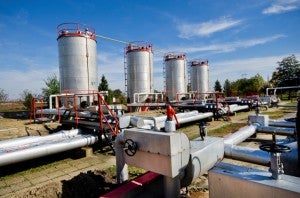Scientists David Lyon and Ramón Alvarez contributed to this post

Two studies released today in the journal of Environmental Science and Technology provide new insights into methane emissions from significant sources in the oil and natural gas sector and underscore the urgency of taking action to address pollution from these sources. The studies—focusing on the gathering and processing segment and the transmission and storage segment—were led by researchers at Colorado State and Carnegie Mellon universities and Aerodyne Research, and included collaboration with EDF and companies in each of these segments.
In the gathering and processing study, researchers measured 130 gathering and processing facilities, finding emissions at gathering facilities ranging from 0.6 to 600 standard cubic feet of methane leaking per minute (scf/m). For the transmission and storage study, a different team led by CSU also collected extensive on-site and downwind measurements of methane at 45 transmission and storage sites. Site-level methane measurements ranged from 2 to 880 scf/m, with an average measurement of 70 scf/m. Of all the facilities measured for these studies, data suggests the natural gas emitted was worth about $25 million and had the 20-year climate impact equal to the emissions of 2 million passenger vehicles.
The Administration has recently announced a goal of reducing methane emissions from the oil and gas sector by 40-45 percent below 2012 levels by 2025—actions that will help prevent this needless waste. The announcement indicates that new standards will build on the technologies EPA evaluated in a set of five peer-reviewed, technical white papers (including technologies to find and fix leaks and to address emissions from compressors).
The studies released today underscore the importance of strong federal actions to reduce emissions from sources in the gathering and processing and transmission and storage segments. In particular, measurements from both of the studies show that equipment leaks are an important source of emissions that can be addressed. Here are some of the findings:
- The gathering and processing study found substantial venting from liquids storage tanks at approximately 20 percent of sampled gathering facilities. Emission rates at these facilities were on average four times higher than rates observed at other facilities, and at some of these sites with substantial emissions, the authors found that company representatives made adjustments resulting in immediate reductions in emissions.
- Researchers found that processing plants leaked at much lower rates than gathering facilities, attributing this discrepancy in part to regulations requiring comprehensive leak detection and repair at processing plants. Moreover, the authors found that 19 of the 25 facilities with the lowest average emission rate were staffed by full time operators.
- In the transmission and storage study, the two sites with very significant emissions were both due to leaks or venting at isolation valves. The study also found that leaks were a major source of emissions across sources, concluding that measured emissions are larger than would be estimated by the emission factors used in EPA’s reporting program.
All of these findings suggest that equipment leaks are an important source of emission and that strong, comprehensive leak detection and repair requirements could help to find and fix these leaks.
The studies also underscore the importance of EPA’s proposed action to strengthen methane reporting requirements for the oil and gas sector (known as Subpart W). In particular, EPA has proposed to require reporting from sources in the gathering and boosting sector, which is critical because there are thousands of these sources across the country and they are not currently required to measure and report their emissions data to EPA.
It is critical that we address methane emissions from the oil and gas sector, and the two studies released today provide additional insights on several important emission sources. As the administration has announced it will take actions to begin to address methane emissions, we must begin working together to deploy commonsense, highly-cost effective technologies to reduce this pollution and minimize waste—solutions that leading states and companies have deployed and that are urgently needed to ensure a level playing field and protect communities across the country.









